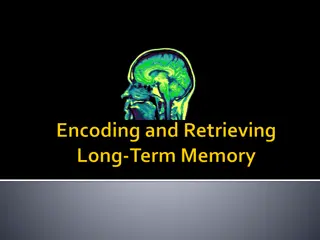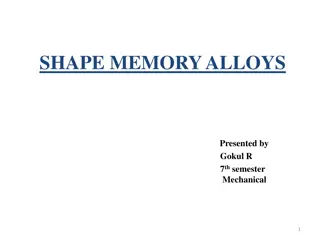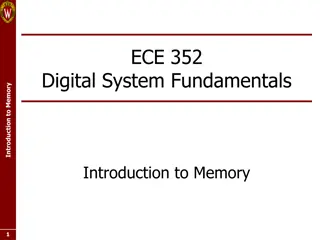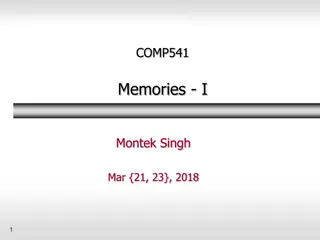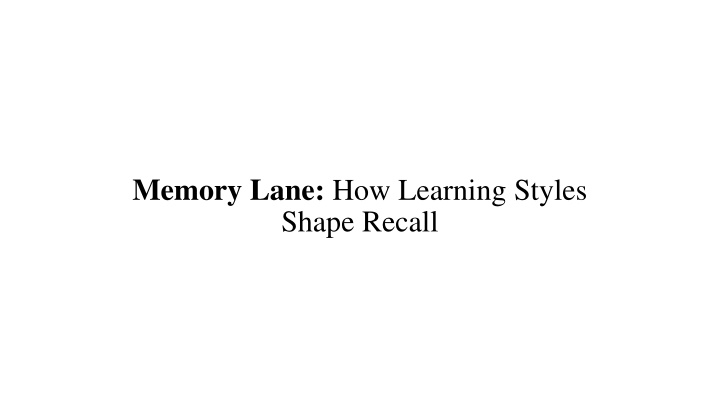
Learning Styles Impact on Memory Recall: Investigating Memory Retention
Explore how learning styles like visual, auditory, and textual impact memory retention. Investigate which learning style enhances short-term and long-term memory recall. Discover the connection between gender and memory retention abilities.
Download Presentation

Please find below an Image/Link to download the presentation.
The content on the website is provided AS IS for your information and personal use only. It may not be sold, licensed, or shared on other websites without obtaining consent from the author. If you encounter any issues during the download, it is possible that the publisher has removed the file from their server.
You are allowed to download the files provided on this website for personal or commercial use, subject to the condition that they are used lawfully. All files are the property of their respective owners.
The content on the website is provided AS IS for your information and personal use only. It may not be sold, licensed, or shared on other websites without obtaining consent from the author.
E N D
Presentation Transcript
Memory Lane: How Learning Styles Shape Recall
Investigating the Impact of Learning Styles on Memory Retention Science Fair Project 2024-2025
Project Overview Exploring How Learning Styles Impact Memory Retention This project investigates how different learning styles visual (seeing), auditory (hearing), and textual (reading) affect a person s ability to remember information. I aim to understand which learning style leads to better short-term and long-term memory retention.
Hypothesis Students who learn by seeing (visual learners) will remember more information, both immediately and over time, compared to auditory or textual learners. This is because visual memory processing is often more effective for recall.
Textual Learning What is Textual learning Textual learners learn best by reading and writing. Whether it s on a screen or in a book, they remember things better when they read and take notes to organize their thoughts. 2
Auditory Learning What is Auditory Learning Auditory learners learn best by listening. They prefer lectures, verbal instructions, and spoken explanations instead of hands-on activities or visuals. Hearing information helps them understand and remember it better. 5
Visual Learning What is Visual learning Visual learners understand information best when it s presented through images, colors, maps, and diagrams. They have a strong ability to picture things in their minds and might even have a near-photographic memory. Seeing information laid out visually, like on a whiteboard, helps them remember it more easily. They learn best by using color- coded notes, making to-do lists, and organizing ideas with concept maps. 1
Does Gender Relate to Memory Retention? Gender can affect memory in different ways. Girls usually have a better memory for events, stories, words, and faces, which helps them remember details faster and with more emotion. However, this advantage tends to fade with age. Boys, on the other hand, are usually better at spatial memory, which means they re better at mentally rotating objects and navigating. 4
Does Gender Relate to Memory Retention- Why These Differences Exist? These differences come from a mix of brain structure, thinking styles, and hormones. Girls have a larger hippocampus, the part of the brain that controls memory, and estrogen may help boost their memory skills. They also tend to focus on small details, while boys remember the big picture. Emotion plays a role too since girls often have stronger emotional connections to memories, they may remember events more vividly. 4
Variables Independent Variable: The learning style (visual, auditory, or textual). Dependent Variable: The amount of information participants remember (memory retention). Controlled Variables: The passage of information, time spent on the learning session, the environment in which participants learn, and the timing of the memory test.
Procedure Start with the seventh graders, then the eighth-grade then ninth grade 1. A group of ten (five girls and five boys) 2. Give them the content and allocate ten minus to study/look over it 3. Test them right after they look over the information (ten-point scale) 4. Test them again 24 hours after (same ten-point scale)
Performance Trends & Retention Patterns (7.1, 7.2, and 7.3) Overall Performance Textual (7.1): 68% 73% (gradual improvement). Auditory (7.2): 79% (best short- term). Visual (7.3): 84% 74% (strong start, but declined). Short-Term vs. Long-Term Retention Textual: Improves with note- taking (72% 77%). Auditory: Best short-term (79%) due to repetition. Visual: Declines over time (84% 74%) unless reinforced.
Group 7: Gender-Based Performance Textual Learning (7.1): Boys outperformed girls: 80% 86% (Boys) 56% 60% (Girls) Auditory Learning (7.2): Girls performed better: 80% (Girls) vs. 78% (Boys) Visual Learning (7.3): Girls had slightly higher scores: Day One: 86% (Girls) vs. 82% (Boys) Day Two: 76% (Girls) vs. 72% (Boys)
Performance Trends & Retention Patterns (8.1, 8.2, and 8.3) Overall Performance Textual (8.1): 72% 76% (improved with note-taking). Auditory (8.2): 70% (slightly lower than textual but improved with active listening). Visual (8.3): 70% 80% (significant improvement with sketching/annotating). Short-Term vs. Long-Term Retention Textual: Improves with note-taking (75% 80%). Auditory: Improves with note- taking (74% 78%). Visual: Strongest improvement (70% 80%), best when paired with active strategies (80% 90% for sketching/annotating).
Group 8: Gender-Based Performance Gender-Based Performance Textual (8.1): Boys outperformed (79% 84%) vs. girls (65% 68%). Auditory (8.2): Boys performed better (78% 82%) vs. girls (62% 66%). Visual (8.3): Boys excelled (80% 90%) vs. girls (60% 70%).
Performance Trends & Retention Patterns (9.1, 9.2, and 9.3) Overall Performance Trends Textual Learning (9.1): 73% 80% improvement Auditory Learning (9.2): 83% on Day One but dropped to 75% Visual Learning (9.3): 90% 80% (highest short-term, but declined) Retention Patterns: Short-Term vs. Long-Term Textual Learning: Improves long-term with note-taking (80% vs. 50%). Auditory Learning: Strong short- term (83%), but 8% drop overnight. Visual Learning: Best short-term recall (90%), but needs reinforcement.
Group 9: Gender-Based Performance Textual Learning (9.1): Males: 82% 90% Females: 64% 60% Auditory Learning (9.2): Males: 81% 74% Females: 85% 77% Visual Learning (9.3): Males: 80% 70% Females
Overall Performance Group Textual Learning Auditory Learning Visual Learning 84% 74% (good short- term, weaker long-term) 68% 73% (gradual improvement) 79% 67% (strong start, drop-off) Group 7 70% 80% (biggest improvement with active engagement) 72% 76% (steady improvement) 70% 78% (best when paired with note-taking) Group 8 73% 80% (best long- term improvement) 83% 75% (high short- term, faded later) 90% 80% (highest initial, still strong later) Group 9
Short-Term vs. Long-Term Retention Textual Learning: Best long-term when paired with note-taking (Group 9 performed best). Passive readers had much lower retention across all groups. Auditory Learning: Strongest short-term recall, but biggest drop over time (Groups 7 & 9). Note-taking & verbal summarization helped memory (Group 8). Visual Learning: Best for immediate recall (Group 9 had highest Day One scores). Engaged learners (sketching, annotating, discussing) retained information better (Groups 8 & 9). Passive viewers lost retention quickly (Group 7 had biggest drop).
Gender-Based Performance Group Group 7 Group 8 Group 9 Textual Boys 80% 86% Boys 79% 84% Boys 82% 90% Auditory Girls 80% 78% Boys 78% 82% Girls 85% 77% Visual Girls 86% 76% Boys 80% 90% Girls 90% 80% Textual Learning: Boys consistently outperformed girls in all groups. Auditory Learning: Girls outperformed boys in Groups 7 & 9, while boys did better in Group 8. Visual Learning: Girls did better in Group 7 & 9, while boys excelled in Group 8.
Applying this Data In Real Life For Teachers: Encourage active note-taking Improves textual learning retention. Use discussions & verbal recall Helps auditory learners remember better. Incorporate visuals & interactive elements Supports deeper comprehension. For Students: Memorize Quickly? Auditory Learning (listening, summarizing). Long-Term Retention? Text-Based Learning (note-taking, highlighting). Understanding Complex Ideas? Visual Learning (diagrams, charts, sketches). Best Strategy?Use a mix of all three styles read, listen, and visualize!
How to Study & Prepare for Tests Short-Term Exams (Quizzes, Unit Tests) Auditory Learning Explain concepts out loud, discuss with others, or record & replay information. Long-Term Learning Text-Based Learning Read actively, take notes, highlight key points, and quiz yourself. Difficult or Abstract Subjects? Visual Learning Helps Use flowcharts, diagrams, concept maps, or color-coded notes to understand ideas. Best Approach?Combine strategies Read it, say it, and visualize it!
Was My Hypothesis Correct? Partially Correct Visual learners had the highest short-term recall (Day One scores were highest across all groups). BUT over time, textual learners retained more if they used active strategies (note-taking, highlighting). Auditory learners showed strong initial recall, but their retention declined the most over time unless reinforced.
Conclusion Through this project, we saw that the way people learn affects how well they remember things. Visual learners remembered the most right away, but their memory faded over time. Auditory learners did well at first but forgot a lot later. Textual learners had the best long-term memory, especially if they took notes. This shows that the best way to learn isn t just one method it s a mix. Using reading, listening, and visuals together can help people remember things better. Teachers can use this to make lessons more effective, and students can use it to study smarter. In the end, what matters most is not just how we get information, but how we use it. Active learning taking notes, explaining things out loud, or drawing diagrams makes a big difference.
Citations 1 Top Hat. (2019, September 16). Visual Learning Definition and Meaning | Top hat. https://tophat.com/glossary/v/visual-learning/#:~:text=Visual%20learning%20is%20a%20type,i Olson, J. (2024, September 11). Visual Learning: A Definitive Guide to the V in VARK. Continue https://www.continu.com/blog/visual-learning 2 Learning styles. (n.d.). https://www.csum.edu/tutoring/learning-styles.html#:~:text=Textual,to%20get%20your%20brain%20flowing. Gragg, M. (2023, July 13). The power of Text-Based learning. eLearning Industry https://elearningindustry.com/the-power-of-text-based-learning 3 Bay Atlantic University. (2024, March 7). 8 Types of Learning Styles | The Definitive Guide. Bay Atlantic University - Washington, D.C. https://bau.edu/blog/types- of-learning-styles/#:~:text=No%2C%20there%20is%20no%20single,most%20effectively%20for%20each%20student. 4 Loprinzi, Paul, and Emily Frith. The Role of Sex in Memory Function: Considerations and Recommendations in the Context of Exercise. Journal of Clinical Medicine, vol. 7, no. 6, 31 May 2018, p. 132, https://doi.org/10.3390/jcm7060132. 5 Auditory learning style explained. (2022, October 25). Western Governors University. https://www.wgu.edu/blog/2020/08/auditory-learning-style.html The Auditory learning style explained: Advantages & Strategies. (2024, March 26). https://www.crawfordinternational.co.za/blog/auditory-learning- style#:~:text=Advantages%20include%3A,rate%20than%20other%20learning%20styles.














